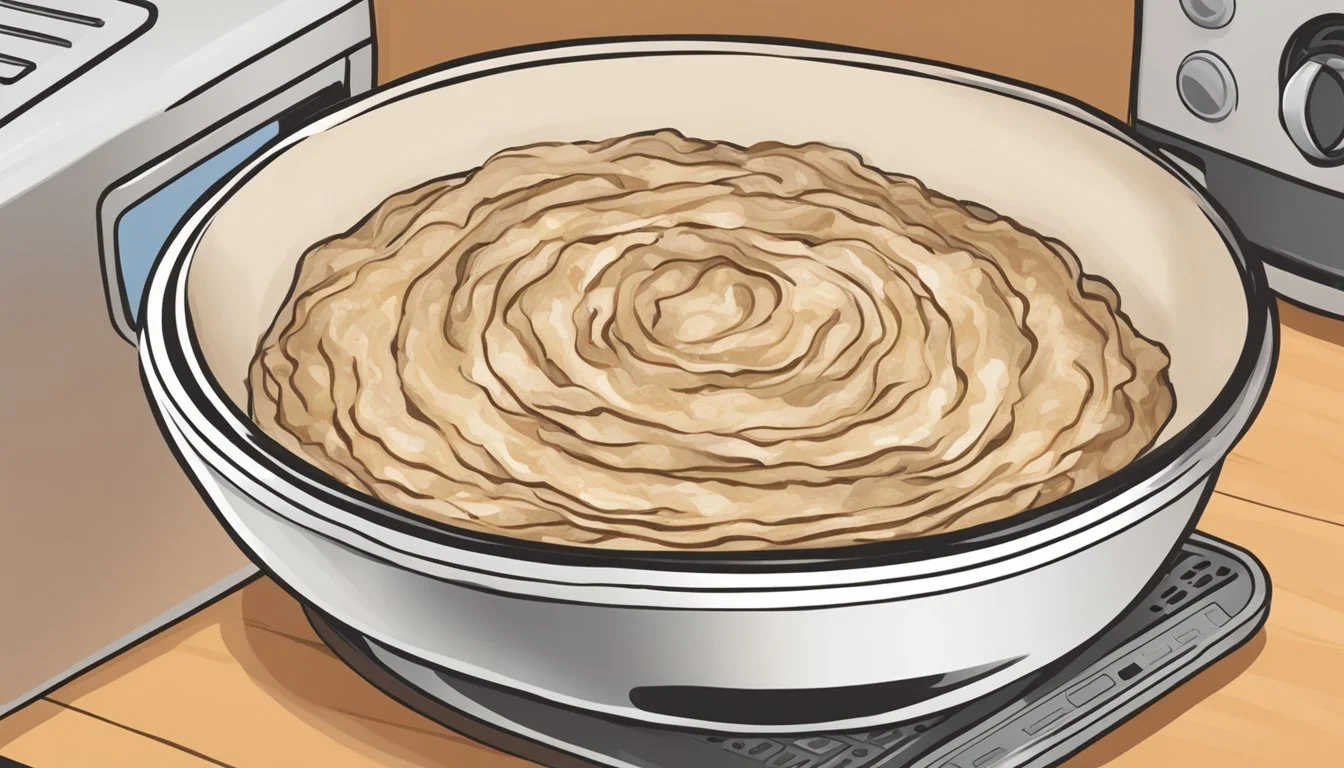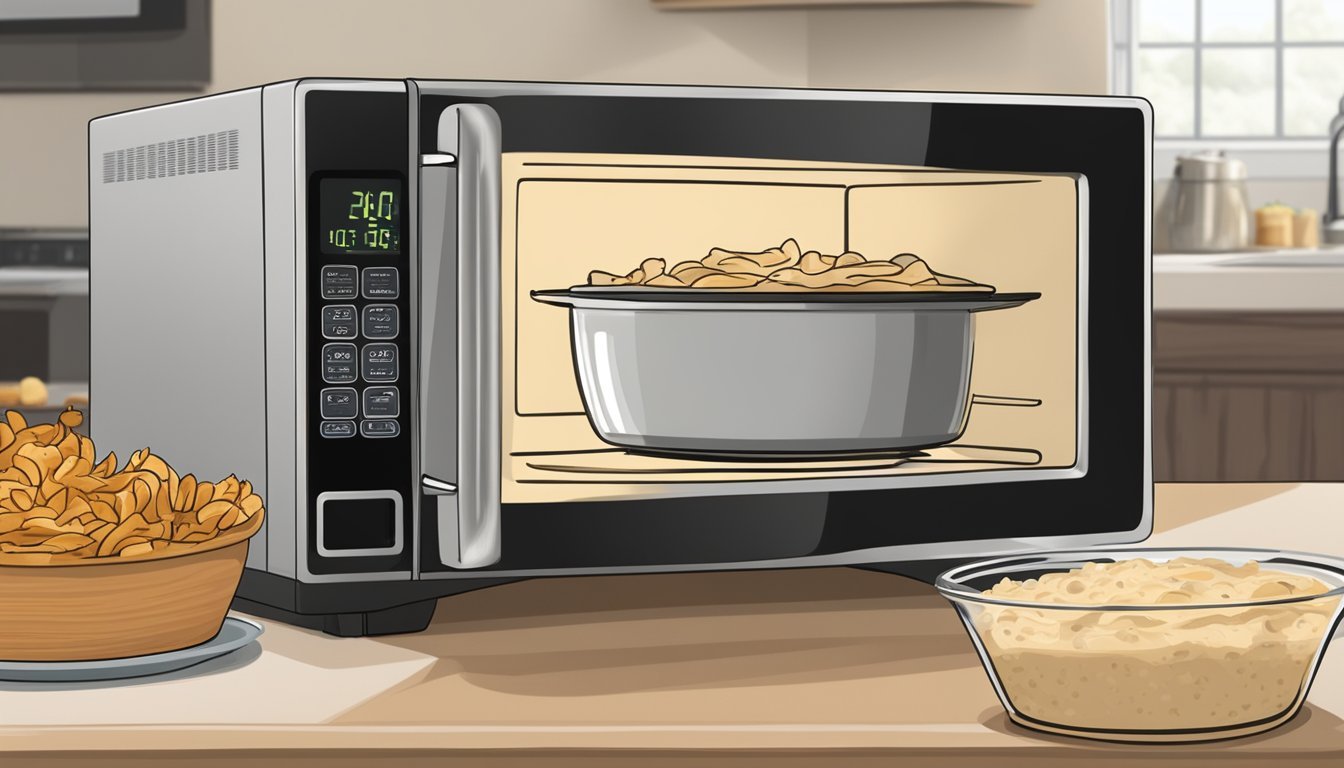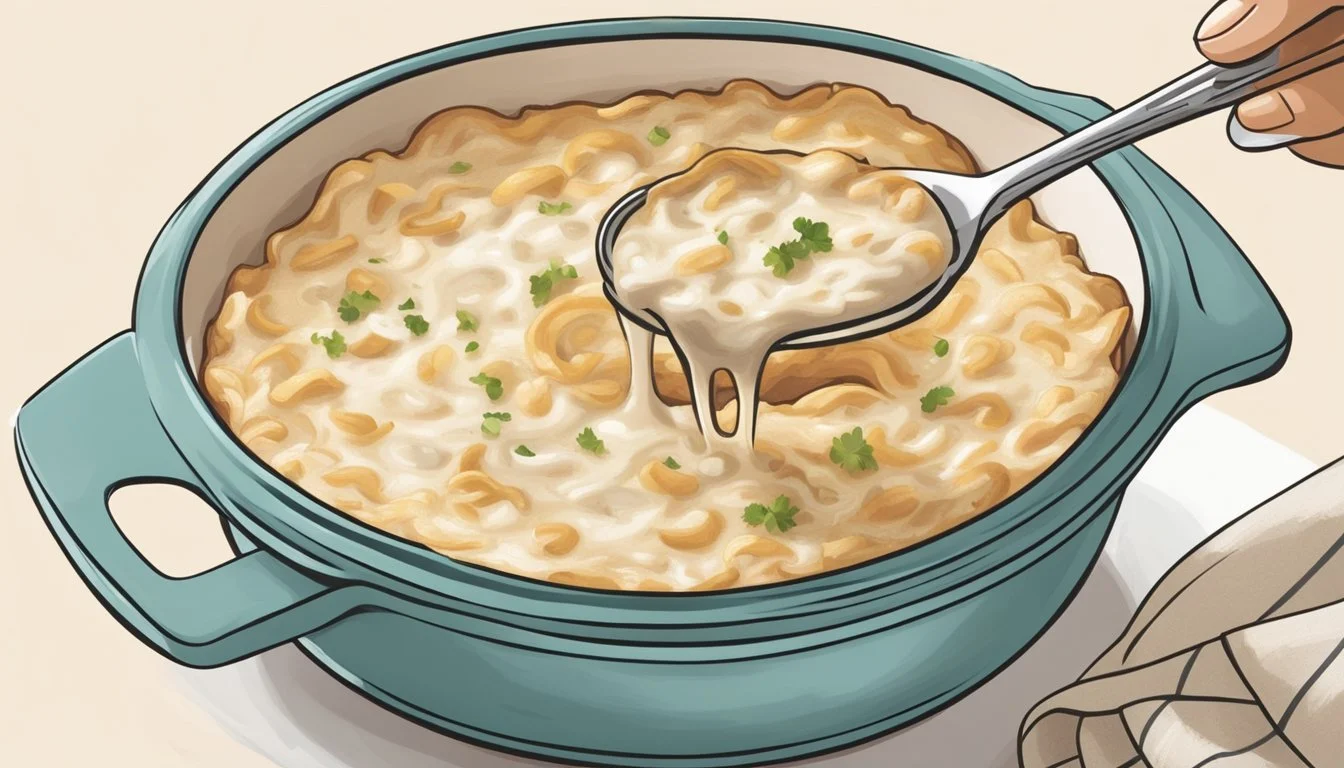Best Way to Reheat Caramelized Onion Dip
Ensuring Creaminess and Flavor Retention
Caramelized onion dip is a classic appetizer known for its sweet and savory flavor profile that comes from the slow cooking of onions until they reach a deep, golden brown. Its creamy texture makes it a favorite at gatherings, but ensuring that this dish maintains its desirable qualities upon reheating can be a challenge. The key to successfully reheating caramelized onion dip lies in preserving its creamy consistency while also keeping the rich flavors of caramelized onions front and center.
The process of reheating the dip should be approached with care, as high heat can separate the ingredients and cause the dip to become oily or grainy. Instead, gentle warming methods should be employed to retain the smooth, velvety texture. Additionally, stirring the dip occasionally during reheating helps distribute heat evenly and prevents any one part of the dip from overheating or drying out.
Maintaining the perfect balance of flavors in caramelized onion dip also requires attention to detail when reheating. The complex tastes developed during the caramelization process can be compromised if reheated too quickly or at too high a temperature. It's important to heat the dip slowly, which allows the flavors to meld together once again, ensuring that every bite is as delightful as when the dip was first made.
Understanding Caramelized Onion Dip
To achieve the perfect balance of flavor and texture in a caramelized onion dip, it's essential to understand the science of caramelizing onions and the role of creamy ingredients.
The Essentials of Caramelization
Caramelization is a process that brings out the natural sweetness in onions through slow cooking. Onions are sliced thinly and then cooked over low heat. This heat gently breaks down the sugars, resulting in a brown and richly flavored base. The key factors in caramelization are time and temperature; onions are best caramelized over medium-low heat for about 25 to 35 minutes, depending on their natural sugar content and the desired level of caramelization.
Temperature Control: A consistent medium-low heat helps avoid burning.
Patience: Caramelization cannot be rushed; slow cooking develops depth of flavor.
Stirring: Regular stirring prevents sticking and ensures even caramelization.
Key Ingredients for Creaminess
The creaminess of a caramelized onion dip hinges on dairy ingredients such as sour cream and cream cheese. These components add a luxurious texture and help balance the robust flavor of the caramelized onions.
Sour Cream: Adds tang and a velvety consistency.
Cream Cheese: Ensures the dip maintains body and richness.
Incorporating these ingredients should be done once the onions have fully cooled to prevent the dairy from curdling and to maintain a smooth, cohesive mixture.
Preparing the Onion Dip
Before one dives into the delightful process of reheating caramelized onion dip, they should ensure they have a well-crafted base. A creamy and flavorful onion dip starts with selecting appropriate onions and following a proven recipe that guarantees success.
Choosing the Right Onions
For the creamiest and most flavorful caramelized onion dip, one should opt for sweet onions. Sweet onions, such as Vidalia or Walla Walla, are less pungent than other varieties and have a natural sweetness that enhances the dip's flavor profile when caramelized.
Types of Sweet Onions Suitable for Caramelization:
Vidalia
Walla Walla
Maui
Texas Sweet
Recipe for Success
The recipe for a successful caramelized onion dip begins with intensive prep work, followed by adequate cook time to achieve the desired depth of flavor.
Steps Description Prep Time Approximately 10 minutes to slice onions finely Cook Time Between 25 to 35 minutes, onions are slow-cooked until golden Total Time 35 to 45 minutes depending on onion variety and desired caramelization level
Basic Ingredients for Reference:
Sweet onions
Butter (for cooking onions)
Sour cream and cream cheese (for creaminess)
Seasonings such as garlic powder
Method:
Slice the onions finely and uniformly.
Cook the onions in butter over medium heat until they start to soften and brown.
Combine cream cheese, sour cream, and any preferred seasonings in a separate bowl.
Mix the caramelized onions into the creamy base until perfectly blended.
One should gently stir the onions continually throughout the cooking process to prevent burning, which is imperative for a smooth taste. Utilizing proper technique in every step from choosing the optimal type of onion to attentive cooking ensures that the dip prepared will be rich in flavor, setting a strong foundation for the later reheating process.
Reheating Techniques
To maintain the creamy consistency and robust flavor of caramelized onion dip, one must choose the right reheating technique. Below are the most effective methods.
Stovetop Method
To reheat on the stovetop, the reader should place their caramelized onion dip in a saucepan over low heat. They must stir frequently to prevent the dip from burning and to ensure even warming. This process helps in preserving the dip's creamy texture and flavorful taste.
Oven-Heated Delight
For a gentle and even heat distribution, reheating in the oven is a superior choice. The reader should preheat the oven to 350°F (175°C), transfer the caramelized onion dip into an oven-safe container, and cover with aluminum foil. Heat the dip until it's warmed through, typically around 10 to 15 minutes, checking periodically.
Microwave Strategies
Microwaving can be convenient, but requires care to avoid altering the dip's texture. The reader should place the caramelized onion dip in a microwave-safe container, cover with a lid or microwave-safe plastic wrap, and heat in 30-second intervals. Stirring between each interval is crucial for retaining a creamy consistency and preventing hotspots.
Storing Onion Dip
Proper storage is crucial for maintaining the quality and freshness of caramelized onion dip. The right temperature and container are key to preserving its creamy texture and flavorful profile.
Refrigeration Tips
For optimal freshness, the dip should be stored in the fridge within two hours of preparation. It's important to keep it in an airtight container to prevent it from absorbing odors and flavors of other foods. The dip is best consumed within 3 days for ultimate taste and texture.
Freezing Essentials
While freezing is not usually recommended due to potential changes in texture, it can be a viable option for longer storage. To freeze caramelized onion dip, use an airtight container or heavy-duty freezer bags to prevent freezer burn. Thawing should be done in the refrigerator overnight before reheating and serving.
Serving Suggestions
When reheating caramelized onion dip, the serving suggestions play a crucial role in enhancing the flavors and ensuring the dip is enjoyed at its best. The choice of accompaniments and the presentation can greatly influence the overall tasting experience.
Accompaniments
Classic potato chips are a popular choice as their crispness contrasts well with the creamy dip.
Crackers provide a firmer texture for those who prefer a crunchier vehicle for their dip.
Veggies:
Fresh vegetables such as carrot sticks, cucumber slices, and bell pepper strips offer a refreshing and healthy option.
They can add a delightful crunch and a balance to the richness of the onion dip.
Presentation Tips
Serving Bowl:
Choose a serving bowl that is both functional and aesthetic. Ceramic or glass bowls can keep the dip cool, especially important if it will sit out for a while.
Arrangement:
Neatly arrange the accompaniments around the onion dip for easy access. Consider grouping the chips, crackers, and veggies in separate sections for variety.
Garnishing:
An optional garnish, such as a light sprinkle of fresh herbs, can add a pop of color and enhance the visual appeal of the dish without overwhelming the taste of the onion dip.
Maintaining Optimal Flavor and Texture
When reheating caramelized onion dip, it's crucial to pay attention to the preservation of its signature creamy texture and rich, savory taste. Balancing the right level of seasonings ensures that the reheated dip maintains its original appeal.
Seasoning Adjustments
During the process of reheating, some of the intensities of the dip's flavor can be diminished. It may become necessary to adjust the seasonings to ensure that the onion dip retains its optimal taste. Salt and pepper, two basic yet essential seasonings, should be tasted for and adjusted if necessary. If the dip was originally seasoned with kosher salt, one should stick with it for consistency in flavor and to avoid over-salting.
Salt: A pinch or two can enhance the overall flavor profile. Kosher salt is preferred for its pure, clean taste.
Black Pepper: Freshly ground black pepper adds a kick, balancing the dip's sweetness with a slight heat.
Sugar: A sprinkle may be needed if the onions have lost some of their natural sweetness due to over-reducing during the initial cooking or the reheating process.
Savory Seasonings: If the dip appears to have lost some of its savory depth, a slight addition of garlic or onion powder can compensate.
One should always taste the dip after adjusting the seasonings and before serving to ensure that the balance of flavors is just right.
Health and Nutritional Information
When considering the reheating of caramelized onion dip, one should be mindful of its nutritional aspects to ensure it remains a wholesome choice. Below is a detailed nutrient breakdown to understand what one typically consumes with a serving of this dish.
Nutrient Breakdown
Calories: Heated caramelized onion dip typically contains moderate calories per serving, mainly from the inclusion of onions and the cream base, which may be sour cream, mayonnaise, or Greek yogurt.
Carbohydrates: Onions are the primary source of carbohydrates in this dip, but overall, it is low in carbs. Dipping agents, such as chips or vegetables, will contribute additional carbohydrates.
Protein: The creamy base, especially if it includes Greek yogurt, can offer a fair amount of protein, making the dip more satiating.
Fat: The fat content varies depending on the ingredients used; full-fat bases will render the dip higher in fat, while use of low-fat alternatives can decrease overall fat content.
Fiber: Onions, being vegetables, are a source of dietary fiber, although the amount in the dip is relatively low due to the high ratio of cream to onions.
Sodium: The seasoning used in the dip, especially if commercial seasoning mixes are used, can contribute significantly to the sodium content.
In moderation, caramelized onion dip can fit into a balanced diet, but one should be aware of the portions due to the varying content of fat and sodium, which can impact overall dietary aims.
Creative Variations
When reheating caramelized onion dip, incorporating different ingredients and flavors can elevate the dish, offering a new twist on a classic favorite. These variations add complexity and can cater to individual dietary preferences or simply refresh a familiar recipe.
Alternative Ingredients
For those looking to alter the base of their caramelized onion dip, traditional sour cream can be substituted with Greek yogurt for a tangier taste and a boost in protein. Using Greek yogurt not only enhances the nutritional profile but also maintains the desired creamy texture. For a heart-healthy option, one can replace some or all of the butter usually used for caramelizing onions with olive oil. This switch contributes to a slightly different flavor profile while also infusing the dip with monounsaturated fats.
Substitutions to consider:
Butter → Olive oil
Flavor Enhancements
Enhancing the savoriness is easily achieved with the addition of Worcestershire sauce during the onion caramelizing process. The umami-laden condiment deepens the dip's savory notes, complementing the sweetness of the onions. A splash of balsamic vinegar introduced near the end of cooking the onions can impart a subtle sweetness and acidity, which balances the rich flavors. While these tweaks are minor, they make a noticeable difference in the final taste of the reheated onion dip.
Flavorful additions:
Umami depth: Add Worcestershire sauce
Sweet and tart balance: Incorporate balsamic vinegar
Troubleshooting Common Issues
In the pursuit of reheating caramelized onion dip to maintain its creaminess and appealing texture, one may encounter common issues such as graininess and separation. This section offers solutions to address and prevent these concerns, ensuring that the dip retains its desirable qualities upon reheating.
Avoiding Graininess
To prevent a grainy texture, it is crucial to reheat the onion dip slowly and gently. Use a double boiler or set the microwave to medium power, stirring the dip every 30 seconds to promote even heat distribution. Maintaining a low heat allows the fats within creamy ingredients like cream cheese or sour cream to melt without coagulating, which is a common cause of graininess.
Preventing Separation
Separation occurs when the components of the onion dip, such as oils and water, fail to emulsify upon reheating. To avert this, one should:
Begin with reheating at a low temperature.
Stir the dip consistently to meld the ingredients together.
Add a small amount of liquid, such as milk or cream, if necessary, to adjust the consistency and encourage the mixture to re-emulsify.
Additionally, avoid letting the dip reach a high temperature, which can cause the fats to separate from the other ingredients, resulting in a less creamy texture and the dip sticking to the pan.
Answering Frequently Asked Questions
When reheating caramelized onion dip, can one still maintain its creaminess?
Reheating in Oven:
Preheat to 300°F (150°C).
Place dip in oven-safe dish.
Heat until warm (do not overheat).
What are the key ingredients to ensuring a flavorful dip upon reheating?
Ingredients:
Use sweet onions for a naturally rich taste.
Fresh garlic enhances depth; avoid substituting with garlic powder for best flavor.
Mayonnaise contributes to creaminess; incorporate before reheating.
Is it possible to reheat in a microwave without drying out the dip?
Microwave Tips:
Short bursts on medium power.
Stir between intervals.
Cover the dip to retain moisture.
How does one avoid the dip from separating or becoming oily?
Stir gently while reheating.
Low and slow warming is key.
Adding a touch of mayonnaise post-reheat can restore texture.
Can caramelized onion dip be made in advance and, if so, how should it be stored?
Advance Preparation:
Store in an airtight container.
Refrigerate for up to 4 days.
Reheat as needed without compromising flavor.
What's the best way to achieve a perfect consistency when reheating the dip?
Consistency:
Consistency is best maintained by gentle reheating.
For cold additions like mayonnaise, fold in after dip is warmed.
By following these guidelines, one can reheat caramelized onion dip while maintaining its creamy texture and robust flavor profile, making it a delightful accompaniment to any meal or gathering.
Connecting with the Community
When it comes to reheating caramelized onion dip, food lovers often seek out community insights for the best methods to keep it creamy and flavorful. Engaging with a broader community can provide valuable tips and variations for perfecting this indulgent treat.
Sharing on Social Media
Community members frequently turn to social media platforms like Facebook, Pinterest, and Instagram to share their culinary successes. They can display their reheated caramelized onion dip with visuals and hashtags to attract others looking for reheating advice. Utilizing these platforms allows for the exchange of knowledge in a visually engaging manner. For instance:
Facebook: Food enthusiasts often join dedicated cooking groups where they can post photos and recipes, asking for feedback on reheating techniques.
Pinterest: Users create boards to pin recipes and can often find step-by-step guides on keeping dips creamy during reheating.
Instagram: A picture tells a thousand words—a post or story of a perfectly reheated caramelized onion dip, tagging the recipes or techniques used, can be quite influential.
Engaging with Fellow Food Enthusiasts
Dedicated forums and comment sections beneath recipe posts serve as excellent places for culinary aficionados to convene. In these spaces, individuals can:
Offer firsthand tips on the reheating process.
Discuss the best oven temperatures and techniques to prevent the dip from separating or becoming grainy.
Debate the merits of incorporating or avoiding certain ingredients or steps that could affect the dip's texture after reheating.








